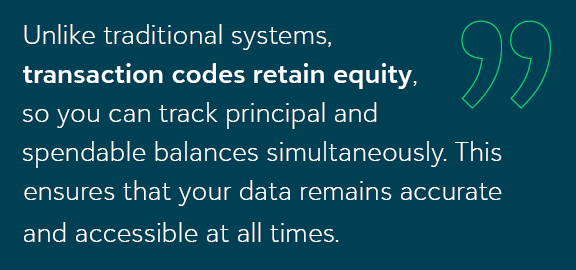How to Effectively Segment Endowment Funds for Your Organization

Managing an endowment is no small feat, especially when you’re stuck relying on Excel spreadsheets or systems that aren’t designed for nonprofit accounting. Juggling donor restrictions, spendable balances, earnings allocations, and long-term sustainability demands clarity, precision, and the right tools.
Without the tools built for managing endowments and other restricted funding, the process can quickly spiral into a web of manual record keeping, and time-consuming reconciliations. Fortunately, the right fund accounting software offers a solution that can transform your endowment management process. By using transaction codes, you can save hours by easily segmenting fund balances, freeing up time to focus on your organization’s mission.
The Pain Point: Excel Overload and Manual Segmentation
Manually managing endowment funds in Excel can be a frustrating endeavor—and risky for even the most savvy Excel users. While spreadsheets can offer flexibility, they often lack the structure you need to handle the complexities of endowment accounting. Broken formulas, outdated links, and accidental overwrites can wreak havoc on your data, leading to hours spent investigating and fixing errors. The larger your endowment and the more funds you’re managing, the more likely these problems will multiply.
Imagine trying to track a hundred endowed funds, all with different purpose restrictions, all participating in your investment pool, with spendable amounts available to various departments on campus. You might have tabs upon tabs of Excel sheets, cross-referencing every transaction to ensure compliance. Now add manual updates for market changes, principal balances, additional gifts coming in, expenditures made, and spendable earnings. The process quickly becomes a logistical nightmare.
Beyond the risk of errors, this manual approach consumes valuable time. Hours spent on tracking data and creating reports could be better used to monitor available amounts and fund utilization or engage with stakeholders. If your current system is holding you back, it’s time to consider an alternative.
Why Segmentation Matters for Endowment Management
Effective fund balance segmentation is the foundation of successful endowment management. Good segmentation clearly defines and tracks the components of your endowment fund balance. This includes identifying the original gift corpus, differentiating between spendable and non-spendable amounts, and understanding the purpose and restrictions attached to each fund.
For example, let’s say your organization receives an endowed gift to fund scholarships. You’ll need to track the principal amount to ensure it remains intact, while monitoring earnings to determine how much is available for distribution and the balance of spendable funds. Additionally, you must adhere to any donor-imposed restrictions, such as using the funds for a specific group of students.
When your data is segmented effectively, it empowers you and your stakeholders to make informed decisions. Leadership teams can quickly see how much can be spent and when, while ensuring compliance with UPMIFA guidelines and donor intentions. Your development team can easily answer donor questions on how the gift is performing. This level of clarity not only streamlines operations but also builds trust with donors and board members, showing the gift’s ultimate impact on the mission of the institution.
Simplify Your Endowment Fund Segmentation with Transaction Codes
Fund accounting software like Blackbaud Financial Edge NXT® offers a game-changing feature that simplifies endowment fund segmentation: transaction codes. These codes allow you to organize and analyze financial data across multiple dimensions, reducing the need for manual tracking and external spreadsheets.
Transaction codes can be tailored to your organization’s needs in other ways, as well. For instance, you can assign codes based on donor, purpose, or fund restrictions, creating a clear and consistent framework for tracking activity. Unlike traditional systems, transaction codes retain equity, so you can track principal, earnings, and spendable balances simultaneously. This ensures that your data remains accurate and accessible at all times.

Using transaction codes makes your life easier by removing a lot of manual data management, which allows real-time insights into your endowment. They also support your organization’s commitment to transparency and accountability. When your data is well-organized and readily available, you can focus on making strategic decisions rather than getting bogged down by manual processes.
Financial Edge NXT Supports Your Endowment Beyond Segmentation
While transaction codes are a powerful tool, Financial Edge NXT offers even more features to support your endowment management. Automated journal entries and allocations save time and reduce the risk of errors, while seamless connection to tools like Blackbaud Raiser’s Edge NXT® and Blackbaud CRM™ ensures your development and finance teams are always in sync.
For organizations with complex compliance needs, Financial Edge NXT simplifies adherence to regulations like UPMIFA. Features like audit-ready reporting and role-based access controls provide peace of mind, knowing that your data is secure and organized. Stakeholders can access view-only dashboards tailored to their needs, promoting collaboration without compromising security.
By combining these capabilities, Financial Edge NXT transforms the way you manage your endowment. You save time, minimize data entry, and create a system that supports efficiency, transparency, and long-term growth.
Streamlining your endowment management doesn’t have to be overwhelming. With the right tools and features, you can simplify segmentation, ensure compliance, and focus on what really matters: fulfilling your organization’s mission.
Learn more about how the right fund accounting software can support your organization’s endowment accounting and give you back more time to focus on more strategic projects.



